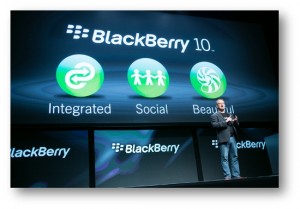
It’s finally go time at Research In Motion. After delays that have tested the resolve of even its most enthusiastic customers, the Canadian company will finally launch its BlackBerry 10 OS on Wednesday and the stakes couldn’t be higher.
The company, which once ruled the mobile messaging market with handsets that encouraged such devoted use that they were compared to crack cocaine, has seen a rough few years. It’s market share, down by more than half in the last year alone, has collapsed as it failed to match increasingly attractive touchscreen smartphones and the changing demands of consumers.
BlackBerry 10 is meant to change all that.
“This is a huge launch for RIM,” said Ted Schadler, Principal Analyst, Forrester Research. “They held off shipping it until it was ready, they made sure there were no bugs. Clearly they wanted to make sure they had the best product in the hands of the right people and the most carriers. That tells you a lot about what’s riding on this for them.”
“This product has to work for them, it’s make or break time for RIM,” he said.
So far, the response from those who have used the new software and the first phones has been good.
“It’s a really positive step for the company,” said Ramon Llamas, an analyst with IDC. “It puts BlackBerry on the same level as Apple, Android and Windows Phone and brings them into 2013 rather than being stuck back in 2010.”
One of the areas that’s getting a lot of the early attention is the phone’s messaging hub, which brings together emails, Facebook messages, Twitter direct messages, SMS and all the other messaging options in the phone. All messages can be read and replied to from the hub, which is available from any screen on the phone.
“On another platform, you’d have to open those applications to respond,” said Schadler. “RIM has it so that with a swipe, you can peek into the hub.”
The phone’s divide between personal and work modes has also been praised. Security settings in work mode can be completely determined and customised by the employer, corporate email can be accessed and company intranet sites visited all without mixing any of that data with the personal mode. In the latter mode, the user is free to do whatever they want on the phone, and there shouldn’t be any impact on the potentially confidential data stored on the work side of the device.
“I liked the navigation,” said Chris Hazelton, an analyst with The 451 Group, who said he’d used one of the first handsets that RIM will unveil next week with partner Verizon Wireless. “It’s different. It’s a good way to manage multiple applications and I didn’t notice any lag. I was very impressed with the performance of the device.”
The messaging and work mode is playing to one of RIM’s strengths: it’s long relationship with corporate IT departments. Those IT departments have to deploy RIM’s BlackBerry Enterprise Server to run the corporate BlackBerry platform and, for the first time, the software also supports management of devices running Apple’s iOS and Google’s Android.
“I’m still not sold on this strategy,” said Hazleton. “It’s not like RIM had a choice in not supporting iOS and Android, but that opens the door to supporting other devices in BlackBerry shops.”
Enterprise IT departments are also fielding advances from Microsoft these days, which just launched its Windows Phone 8 OS. Microsoft, like RIM, has deep roots in enterprise IT work and with the BlackBerry 10 launch the two companies will battling for third place in the smartphone market.
“That’s a hard race to handicap,” said Schadler. “Unless you look at the size of the companies, the amount of money they can spend and the amount of money they can stand to lose. And that’s when it gets tough for RIM.”
Stockholders appear bullish on the chances of BlackBerry 10. The company’s share price has more than doubled since mid-September, when it reversed a slide that had been going on for months, but at around US$17, it still remains well below the high of June 2008 when it was trading above $140.
For the coming year, IDC predicts RIM’s market share will fall slightly to 4.4 percent of the smartphone market. Phone shipments will rise from just over 40 million in 2013 to just over 58 million in 2016, said IDC. But that’s slightly behind overall smartphone market growth, so RIM’s market share is forecast to slide further to 4.2 percent in 2016, the research company said.





